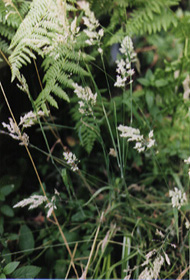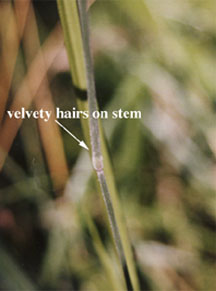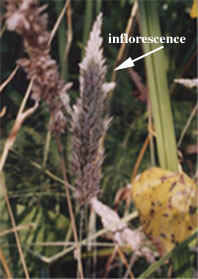


General Species Description
- Common velvetgrass is a tufted perennial grass known for its soft, hairy, "velvety" stems. The stems are weak and hollow with open sheaths and flat, membranous ligules topped with short hairs. It grows up to one meter tall.
Leaves
- The leaves of common velvetgrass are flat and 3-10 mm wide with ligules 1-2 mm long. Leaves are covered with soft gray hairs.
Inflorescence/Flowers
- The spikelets of common velvetgrass are two flowered and crowded onto compact panicles, usually 5-15 cm long. The upper flowers are male and the lower flowers are both male and female. Glumes are hairy, equal in size, and longer than the lemmas. Lemmas are smooth and shiny, almost leathery and fringed with short hairs. The awn of the uppermost floret is bent like a hook. The infloresence is purplish when new and then fades to tan. Each infloresence is between 5 and 15 cm long. Common velvetgrass blooms from May to September.
Fruits
- Description of fruits. Obvious and sublte features.
Habitat
- Common velvetgrass prefers moist soils and is usually found along roadsides, in planted meadows and in other disturbed areas. It can also be found in unimproved pastures or agricultural areas. It is especially found in and around human settlements.
Range
- Common velvetgrass is common in western Washington and Oregon as far south as California. It has been found scattered throughout the United States.
Similar Species
- Similar to the common velvetgrass is the creeping velvetgrass (Holcus mollis). Creeping velvetgrass is not as hairy as common velvetgrass and it grows in creeping rhizomes rather than tufted clumps. The infloresence of creeping velvetgrass is much greener than common velvetgrass. The awns of creeping velvetgrass also differ from common velvetgrass in that they are bent rather than hooked. Also the lemma of creeping velvetgrass are not shiny and have a bearded base.
Ecological Value
- The leaves and stems of common velvetgrass are grazed upon by deer as well as domestic animals.
Human Value
- Common velvetgrass is one of many grass species that has become able to develop populations that are tolerant to toxic concentrations of heavy metals such as copper, zinc, lead and arsenic.
References
- Cooke, Sarah Spear, 1997. A Field Guide to the Common Wetland Plants of Western Washington & Northwestern Oregon. Seattle Audubon Society and Washington Native Plant Society. Seattle Audubon Society. Seattle WA, 417pp. Pojar, Jim and MacKinnon, Andy, 1994. Plants of the Pacific Northwest Coast; Washington, Oregon, British Columbia & Alaska. B.C. Ministry of Forests and Lone Pine Publishing. Canada, 527pp. USDA Natural Resource Conservation Service, 199 . Western Wetland Flora. West Region. Sacramento CA.
This page was created by: Mandy Summer, August 1998
Return to Northwest Oregon Wetland Plants Project